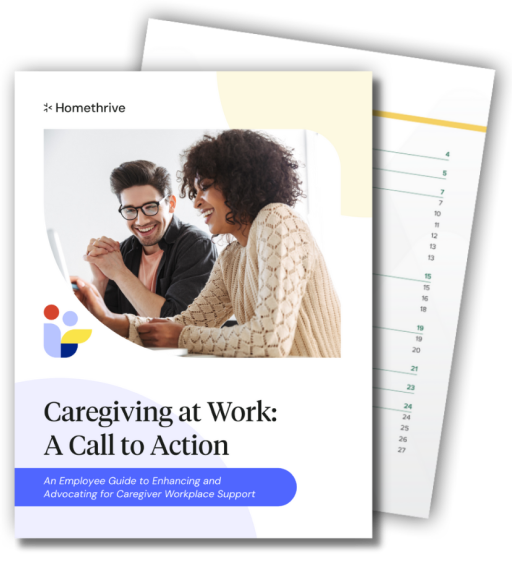What is an Employee Resource Group?
Employee Resource Groups (ERGs), sometimes called affinity groups, are a diversity and inclusion initiative to help workers connect and raise awareness about issues facing their workplace, while empowering them to advocate collectively. ERGs are voluntary and employee-led, and should be formally supported by an organization.
In this article, you’ll learn how to start an employee resource group for caregivers at your organization.
Creating an Employer Resource Group for Caregivers: A Journey
If you want to be a voice for change, you must find others who share your views and struggles and who are willing to go with you. The strength of a group will help you get much further than you will alone. Here are the seven parts of your journey to an effective caregiver employee resource group and the ultimate destination: increased support and enhanced programs, policies and benefits.

1. Find a travel buddy
If you have to take the first step by yourself, so be it, but if you can find a few or even one other person to walk with you, you’ll have a lot more energy and motivation to keep going. Share your caregiving story with a few trusted colleagues and see what emerges. Being vulnerable is often the key that opens the door to discovering others in similar circumstances.
2. Expand into a tour group
Attract wider interest in your group with a company survey. Work with your human resources department to get a simple survey included in upcoming employee emails or on the company intranet, or make an announcement about your group at your next all-hands meeting and have interested people contact you.
Be sure to include language inclusive of people who may not be caregivers themselves but who intimately understand and sympathize with the caregiving struggle. This kind of advocate may have more energy to give to the group than actual caregivers, who might already buckling under the demands of juggling work and caregiving.
3. Gather to talk about your trip
Once you have a critical mass of people (this will depend on the size of your company), hold an in-person or video meeting to discuss your needs and wants.
At this stage, you’ll want to establish the foundational mission of your group, in one or two sentences, that addresses the purpose of your group and a general destination: the main thing you want to accomplish. This gives your group a north star to follow and will help you move more easily through the rest of your journey.
4. Secure necessary travel documents
Support and approval from above is absolutely critical. With your mission statement ready, ask to meet with executive leadership or the head of human resources to explain the purpose and goals of your Employee Resource Group.
Come equipped with statistics, data and the business case for why your employee resource group should exist — much of which you can find in the Caregiver-Friendly Workplaces Toolkit. With the permission of your members, present a list of people in your group so that leadership can see just how many workers are also known caregivers. Better yet, have group members attend the meeting with you.
Your goal for this stage is to receive an official endorsement from leadership to continue working as an employee resource group. Ideally, you can identify an ally or two on the leadership team willing to advance your cause should the need arise. It’s highly possible that you can find one, as caregivers are emerging in all walks of life and company hierarchy.
5. Invite more travelers to join you
Keep promoting your group in employee communications and encourage group members to reach out to other caregiver co-workers. Data shows that about half of employee caregivers never share their caregiving status with their workplace. It will be important for your group to be highly visible, so that reticent employees will be comfortable coming forward.
A special recruitment tool could be to host a screening of the “Unseen” documentary, an honest and unfiltered glimpse into the lives of caregivers that truly demonstrates the mental and physical struggle of caregiving for children and adults who are disabled or medically complex.
As you probably know, this is a group already overworked in life, and while many will desperately need change, few will have the extra time or energy to devote to the cause. It will take a special few leaders that can be champions for the group — perhaps even some members who are not caregivers themselves but have a close relationship with one and understand their pain.
6. Lock in your final destination
Now that you have the support of leadership and a strong representation of caregivers in your group, it’s time to do the work of deciding on the change you want from your organization.
Study the content of Caregiver-Friendly Workplaces Toolkit, such as the free assessment, How Caregiving-Friendly Is Your Workplace?, and the articles about how Culture, Flexibility, Employee Benefits and Communication are critical components.
With a full understanding of where your workplace is now and what the possibilities are for change, craft a plan for your group to present to leadership and human resources to move from potential to policy. The plan should concisely outline requested changes to policy and benefits, with supporting data and rationale.
7. Keep going until you get there
Your journey will be inspirational in some places, tedious in others and even rocky at times, so you just have to keep on keeping on until you arrive at your destination: the realization of the goals and policy changes that employee caregivers need to be productive workers while also fulfilling their caregiving responsibilities. What a great view!







